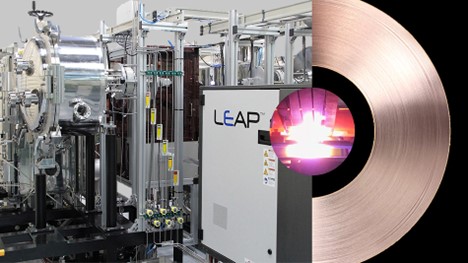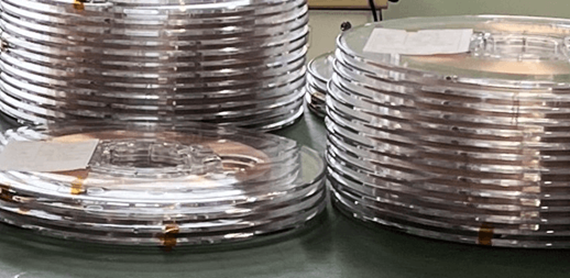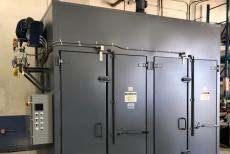
The prospect of carbon-free energy from fusion has accelerated the development of tokamaks in recent years, driving the demand for high-temperature superconductor (HTS) tape, the technology at the heart of the extremely strong electromagnets used to confine plasma in magnetic-confinement fusion reactors. Now, manufacturers of HTS tape, notably Faraday Factory and Fujikara, both located in Japan, are ramping up their production capabilities and deliveries as the global demand for HTS tape is expected to grow tenfold in the next five years. Lasers from Coherent Corp. are playing a key role.
Faraday has recently partnered with Coherent, a manufacturer of industrial lasers, to scale up manufacturing of HTS tape to enable mass deployment of nuclear fusion reactors. Coherent LEAP excimer lasers provide pulsed laser deposition that enable the manufacturing of HTS tape. Faraday Factory Japan, a subsidiary of Faraday 1867, says it is the world’s largest producer of HTS tape. In October, the companies signed a letter of intent outlining a strategy to increase manufacturing capacity at Faraday’s factory in Japan with excimer lasers from Coherent.

“We understand that countries in the nuclear fusion energy race are looking to ramp up sustainable supply chains of HTS tape on the order of thousands of kilometers per year to keep fusion technology development on a fast track,” said Dr. Kai Schmidt, senior vice president, Excimer Laser Business Unit at Coherent. “We have been partners with Faraday 1867 for more than ten years, and we are eager to supply the lasers that will support the production ramp-up phase of HTS tape.”
“Thanks to our collaboration with Coherent, our HTS tape is already designed into some of the most advanced magnetic-confined fusion devices in the world that continue to achieve breakthroughs on the path to clean and abundant fusion energy,” said Dr. Sergey Lee, representative director of Faraday Factory Japan. “Applications for HTS tape go beyond fusion reactors: They include loss-less energy transmission, zero-carbon aviation and container ships, helium-free MRI systems, advanced propulsion for spaceships, and many more. Combined, these applications are driving the double-digit annual percentage growth of the market for HTS tape, which is increasing the urgency to invest in HTS tape manufacturing capacity.”
HTS tape is one of the key technologies that enable magnetic-confinement fusion reactors like tokamaks, which have much simpler designs, are more compact, and have lower operating costs than previous technologies. HTS tape can operate at temperatures of tens of Kelvins, which eliminates the need for costly cooling systems based on non-sustainable liquid helium technology. Magnetic-confinement fusion reactors are expected to eventually be capable of producing gigawatts of carbon-free power with a net gain of greater than ten and could therefore play a game-changing role in the global transition to green energy.
Earlier, Naoki Okada, president and CEO of Fujikara, announced in February that his company delivered mass-production volumes of rare-earth-based high-temperature superconducting tapes to Commonwealth Fusion Systems (CFS) and has begun expanding production capacity for the tapes. CFS is a well-funded startup, featured in an earlier article in Magnetics Magazine, which is planning to build the world’s first commercially relevant fusion machine in the U.S. It was spun out from Massachusetts Institute of Technology to build on decades of research combined with new groundbreaking HTS magnet technology and the speed of the private sector to bring fusion energy to market. The mission is to deploy fusion power plants to meet global decarbonization goals as fast as possible. The company is supported by leading global investors. Its HTS magnets are designed to enable significantly stronger magnetic fields and, as a result, significantly smaller tokamaks.
Since the discovery of high-temperature superconductivity, Fujikura has continued to be a world-class leader in both research and development of high-temperature superconductivity, now providing high-performance, highly uniform rare-earth-based high-temperature superconducting tapes in Japan and overseas.
“Fujikura’s rare-earth-based high-temperature superconducting tapes are crucial for creating a fusion machine,” said Okada. “We have high current capability in an ultra-high magnetic field and high strength capabilities. We are proud to announce that after years of advancement of our technological capabilities, Fujikura Ltd. has now established mass production technology to meet these requirements.”
“We are excited to be working with Fujikura Ltd. as one of our partners providing HTS superconductors for use in our fusion magnets for SPARC,” said Brandon Sorbom, chief science officer and co-founder of CFS. “We have been extremely impressed with the performance of Fujikura HTS and look forward to working with them to scale up their production to meet the high volumes of superconducting tape the fusion industry will need as it grows.”

High-temperature superconducting tapes and fusion
As explained by Fujikara, superconductivity is a phenomenon in which the electrical resistance becomes zero when the temperature falls below a certain level. Superconductivity comprises low-temperature superconductivity (metallic superconductivity), which uses liquid helium (Boiling point: -269C) for cooling, and high-temperature superconductivity (oxide superconductivity), which manifests superconductivity even at high temperatures without using liquid helium.
Superconductive tape on which oxide superconductive material made of substances such as rare earth is deposited through an intermediate layer onto a tape-like metal substrate such as a long metal tape with a nickel-based alloy. It holds its key properties even in a magnetic field and is expected to be widely used to realize future next-generation superconducting devices in the future.
The source of the sun’s energy, nuclear fusion is a reaction in which the nuclei of atoms with small mass fuse with each other, generating enormous amounts of energy in the process. Since the source of this resource is abundantly contained in seawater and does not produce carbon dioxide, it is considered a promising power generation method for realizing a carbon-neutral society in the future.


For more info, see www.faradaygroup.com, www.fujikara.com, www.coherent.com and www.cfs.energy.



